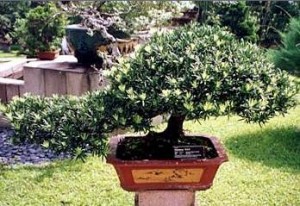One of my favourite non ficus ginseng varieties of bonsai is bonsai podocarpus. Bonsai podocarpus is from the pine variety of trees and has several sub-categories including podocarpus alpinus – a dwarf form, podocarpus macrophylla or Buddhist pine, podocarpus macrophylla Maki, podocarpus nagi or yellowwood which is native of Japan, China and Taiwan and lastly podocarpus nivalis an alpine tree. All varieties have the distinctive dense, green pine needles with some varieties growing as high as 30 metres.
With its rich dark green foliage it is in my opinion one of the more beautiful varieties of bonsai which can be survive both indoor and outdoors. The bonsai podocarpus is a slow growing variety of bonsai but will grow at a quicker pace if given direct sunlight. It’s important to note that too much sunlight could result in burning of the leaves and drying of the soil. While it does not need direct sunlight and can be kept indoors, you may be waiting for an extended period for your bonsai podocarpus to grow.
Watering your bonsai podocarpus should be done regularly, along with misting of the leaves if kept indoors. While the bonsai podocarpus does enjoy a moist soil base it also requires suitably fast draining acidic soil. Feeding or fertilizing can be done fairly regularly during summer, perhaps as often as every two weeks and in summer reduce this by at least half.
Bonsai podocarpus does handle a savage pruning during growing season, however be more careful with the roots when re-potting as these do not handle a similarly intensive pruning. For best results, the rule of thumb is to prune no more than 1/10th of the original root system. Overall a wonderful bonsai for all seasons, but do remember this plant prefers temperatures above 10°C and while it will survive light frosts, its best to keep in doors during the colder months.




